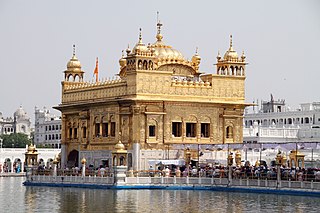
Sikhism, also known as Sikhi, is a monotheistic religion and philosophy that originated in the Punjab region of the Indian subcontinent around the end of the 15th century CE. It is one of the most recently founded major religious groups and among the largest in the world with about 25–30 million adherents.
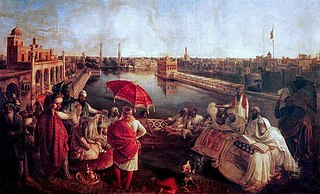
Sikhs are an ethnoreligious group who adhere to Sikhism, a religion that originated in the late 15th century in the Punjab region of the Indian subcontinent, based on the revelation of Guru Nanak. The term Sikh has its origin in the Sanskrit word śiṣya, meaning 'seeker', 'disciple' or 'student'.

The Guru Granth Sahib is the central holy religious scripture of Sikhism, regarded by Sikhs as the final, sovereign and eternal Guru following the lineage of the ten human gurus of the religion. The Adi Granth, its first rendition, was compiled by the fifth guru, Guru Arjan (1564–1606). Its compilation was completed on 29 August 1604 and first installed inside the Golden Temple in Amritsar on 1 September 1604. Baba Buddha was appointed the first Granthi of the Golden Temple. Shortly afterwards Guru Hargobind added Ramkali Ki Vaar. Later, Guru Gobind Singh, the tenth Sikh guru, added hymns of Guru Tegh Bahadur to the Adi Granth and affirmed the text as his successor. This second rendition became known as the Guru Granth Sahib and is also sometimes referred to as the Adi Granth.
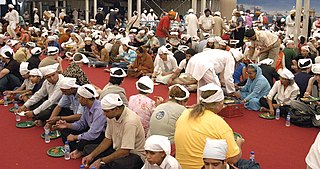
In Sikhism, a langar is the community kitchen of a gurdwara, which serves meals to all free of charge, regardless of religion, caste, gender, economic status, or ethnicity. People sit on the floor and eat together, and the kitchen is maintained and serviced by Sikh community volunteers who are doing seva. The meals served at a langar are always lacto-vegetarian.

The term Khalsa refers to both a community that considers Sikhism as its faith, as well as a special group of initiated Sikhs. The Khalsa tradition was initiated in 1699 by the Tenth Guru of Sikhism, Guru Gobind Singh. Its formation was a key event in the history of Sikhism. The founding of Khalsa is celebrated by Sikhs during the festival of Vaisakhi.

The Ardās is a set prayer in Sikhism. It is a part of worship service in a Gurdwara, daily rituals such as the opening the Guru Granth Sahib for prakash or closing it for sukhasan in larger Gurdwaras, closing of congregational worship in smaller Gurdwaras, rites-of-passages such as with the naming of child or the cremation of a loved one, daily prayer by devout Sikhs and any significant Sikh ceremonies.
Ravidassia or the Ravidas Panth is a religion based on the teachings of Guru Ravidas. It was considered a sect within Sikhism until 2009. However, some Ravidassias continue to maintain Sikh religious practices, including the reverence of the Guru Granth Sahib as their focal religious text, wearing Sikh articles of faith (5Ks), and appending Singh or Kaur to their names.
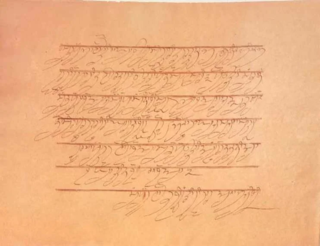
Chandi Di Var also known as Vaar Durga Ki is a composition written by Guru Gobind Singh, included in the 5th chapter of Dasam Granth.
The Sikhs engage in various rites and services. Sikh rites include activities they consider essential to the group practice of Sikhism or the expression of egalitarianism, such as kirtan or taking karah parshad. Many rites in Sikhism involve prayer (ardas) or reciting scripture (paath). Some Sikh rites are meant to be practiced in a gurdwara congregation, while others are practiced at home or in other contexts.
Bibliolatry is the worship of a book, idolatrous homage to a book, or the deifying of a book. It is a form of idolatry. The sacred texts of some religions disallow icon worship, but over time the texts themselves are treated as sacred the way idols are, and believers may end up effectively worshipping the book. Bibliolatry extends claims of inerrancy—hence perfection—to the texts, precluding theological innovation, evolving development, or progress. Bibliolatry can lead to revivalism, disallows re-probation, and can lead to persecution of unpopular doctrines.
Followers of Sikhism do not have a preference for meat or vegetarian consumption. There are two views on initiated or "Amritdhari Sikhs" and meat consumption. "Amritdhari" Sikhs can eat meat. "Amritdharis" that belong to some Sikh sects are vehemently against the consumption of meat and eggs.

Sikhism prohibits idolatry, in accordance with mainstream Khalsa norms and the teachings of the Sikh Gurus, a position that has been accepted as orthodox.
Sikhism has often been criticised by non-Sikhs regarding its texts, practices, and societal norms, but Sikhs and other scholars argue that these criticisms are flawed and are based on a biased and poor understanding of the texts, especially of the multiple languages used in the Sikh scriptures. They also argue that most Western scholars who attempted to interpret Eastern religious texts were missionaries and could not overcome the bias they carried with them, irrespective of whether they were translating the Quran, Vedas, Puranas or the Guru Granth Sahib. Sikhism's founder Guru Nanak rejected ritualistic worship and encouraged belief in one God: Waheguru. The veneration and bowing to the Guru Granth Sahib, has often been interpreted by Western scholars as akin to idolatry, as observed by the Hindu faith, which defeats the ideology of Guru Nanak. Other scholars dismiss Sikhism as, either consciously or spontaneously, a syncretism of the Hindu Bhakti and Islamic Sufi movements.
Sikhism in Austria is a very small religious minority. There are about 10,000 Sikhs in Austria. As of 2012 there were three gurdwaras in Austria. As per Austrian government, Sikhism is now an official religion in Austria. The local population of Sikhs can now use Singh and Kaur as their last name.
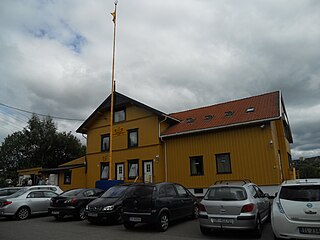
In Norway, Sikhism has approximately 5,000 adherents, mostly living in Oslo. Oslo collectively has two gurdwaras.
Knut Axel Jacobsen is a Norwegian scholar of the history of religions and professor at the University of Bergen. He is a member of the Norwegian Academy of Science and Letters.

Sikhism is a small minority religion Finland. There are approximately 600–700 Sikhs living in the country.
Sikhism in Denmark is a minority religion. There are estimated to be 5,000 Sikhs living in Denmark.

Sikhs in Portugal is a minority religion. The Sikh community in Portugal is a small but vastly growing one. According to the latest available data, there are estimated to be around 35,000 Sikhs living in the country. The Sikh population in Portugal has grown over the years, with many Sikhs migrating to the country for agricultural work, construction work or to start their own businesses.

Sikhs in the Republic of Ireland are a religious minority in Republic of Ireland. There are 2,173 Sikhs living in Ireland per the 2022 census of Ireland.














